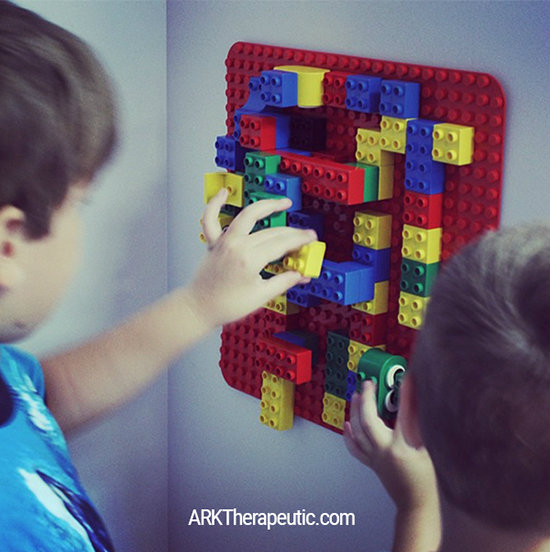Building a Therapy Lego Wall
Posted by Debra C. Lowsky, MS, CCC-SLP on 31st Mar 2016
A lego wall is a very simple DIY project that packs a ton of therapeutic benefit. To assemble: simply attach a lego board to a wall. Mine is from at least 20 years ago so I don't know the exact brand anymore, but any lego / brick set that comes with a mat to stack them on should work. Then I used heavy-duty velcro to attach it on the wall. There's probably a better way of attaching it to the wall, but I've had this up with velcro for almost a year and it's still going strong.
.

.
.
WHAT SKILLS DOES THIS ACTIVITY WORK ON?
As a speech therapist I use this building block station to help kids work on spatializations, motor planning, eye-hand-coordination, and social skills. I don't personally work on colors in therapy (usually colors are practiced at length at home, so I focus on other goals), but this would be a great opportunity to work on color identification as well.
Pushing blocks against the wall can be calming, as it provides proprioceptive input / resistance to the muscles. So it's a fun, regulating activity for kids, especially in the beginning of therapy so they can then get the most out of their sessions.
A lego wall also works on shoulder strength (since it's done out in space without support to the arm), wrist and intrinsic hand strength (which are needed to grasp the lego and to provide enough force to push/pull it on/off the wall), and wrist extension (working on a vertical surface of any kind is good for this). All of which are important factors for improving one's grasp of writing utensils and/or small objects.
.

.
.
IDEAS TO MAKE THE LEGO WALL HARDER:
• Have the child try to copy a design that you have made. To make this activity the easiest - put the design right next to his/her area (on the same vertical surface). To make it harder - put the design down on the floor or a table so that he/she must look back and forth between the design and the wall. To make it the hardest - put the design across the room so that he/she must go over to it, study it, and commit to memory where each lego goes.
• Have the child sit or stand on a movable surface (couch cushion, therapy ball, busy seat, etc.) while using the lego wall to engage all muscles of the body.
• Have the child use tongs or tweezers to pick legos up off floor and place them on the board. This works on increasing control, gradation of force, and targeting.
• Have the child follow multi-step directions and sequencing by telling him/her to put on a red piece, then yellow, then green - in that order. The longer the sequence, the harder it will be.
• With multiple kids you can have them work together to create a certain picture (sun, house, flower, etc.). They can take turns putting one lego on at a time, practicing team-work, social skills, problem-solving, and visual spatial/motor skills.
.
IDEAS TO MAKE THE LEGO WALL EASIER:
• Change the size of the legos: Larger bricks/legos are the easiest to grasp. Small bricks/legos are the hardest.
• Change the angle of the board - tilt the board out so that it's less vertical.
• Place the board right at eye level.
• Use hand-over-hand assistance to place legos on the board, or assistance at elbow to help get the arm up to the correct level and/or to push the pieces on.
.
Lego walls make a great addition anywhere - classrooms, waiting rooms, playrooms, etc.
.
Have fun!
Debbie
Debra C. Lowsky, MS, CCC-SLP
.
